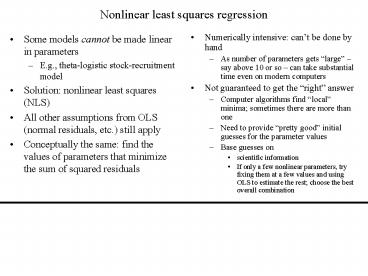Nonlinear least squares regression - PowerPoint PPT Presentation
1 / 14
Title:
Nonlinear least squares regression
Description:
E.g., theta-logistic stock-recruitment model. Solution: nonlinear least squares (NLS) ... library(car) qq.plot(resid(fish.nls)) plot(fitted(fish.nls),resid(fish. ... – PowerPoint PPT presentation
Number of Views:266
Avg rating:3.0/5.0
Title: Nonlinear least squares regression
1
Nonlinear least squares regression
- Some models cannot be made linear in parameters
- E.g., theta-logistic stock-recruitment model
- Solution nonlinear least squares (NLS)
- All other assumptions from OLS (normal residuals,
etc.) still apply - Conceptually the same find the values of
parameters that minimize the sum of squared
residuals
- Numerically intensive cant be done by hand
- As number of parameters gets large say above
10 or so can take substantial time even on
modern computers - Not guaranteed to get the right answer
- Computer algorithms find local minima
sometimes there are more than one - Need to provide pretty good initial guesses for
the parameter values - Base guesses on
- scientific information
- If only a few nonlinear parameters, try fixing
them at a few values and using OLS to estimate
the rest choose the best overall combination
2
NLS in R
- Need the nls library
- The function is nls()
- The formula is like a real equation, with all
parameters specified - Specify the initial values for the parameters
(this also tells nls which things in the formula
are parameters) - Trace prints out the progress, which can be
handy if things arent going well - If the method doesnt converge, sometimes you can
help things along by increasing maxiter or
decreasing minFactor or tol
- library(nls)
- nls(
- log(Recruits) b0 b1log(Spawners)
b2Spawnerstheta, - startc(b0-11, b12.2, b2-3, theta.5),
- traceT,
- controlnls.control(maxiter100,
minFactor1/2048, tol1e-4) - )
3
Formula log(Recruits) b0 b1 log(Spawners)
b2 Spawnerstheta Parameters
Estimate Std. Error t value Pr(gtt) b0
28.5369 72.1780 0.395 0.695 b1
-2.0301 5.4898 -0.370 0.714 b2
-610.9205 4810.6300 -0.127 0.900 theta
-0.5404 1.4118 -0.383 0.704 Residual
standard error 0.7716 on 34 degrees of
freedom Correlation of Parameter Estimates
b0 b1 b2 b1 -0.9998
b2 0.9847 -0.9809 theta 0.9919
-0.9890 0.9988
4
(No Transcript)
5
(No Transcript)
6
Dangers of nonlinear regression
- You can get similarly good fits with very
different looking functions - OK for interpolating
- Different models will produce very different
predictions when extrapolating
- For interpolating, we can find the best
nonlinear model using nonparametric regression - E.g., lowess (locally weighted sum of squares)
- This is what you see in diagnostic plots that try
to indicate the nonlinear trend in residuals
(e.g., CR plots)
7
(No Transcript)
8
(No Transcript)
9
Splines and GAM
- Another smoothing function is the cubic spline
- A bunch of cubic polynomials fit locally and
joined together - Allows us to fit a generalized additive model
(GAM)
- Good when scientific theory tells us which
variables should be important but not whether the
effects should be nonlinear or what form of
nonlinearity - Can use GAM model directly for interpolation, or
use to decide which nonlinear functions to use
with nls
10
Family gaussian Link function identity
Formula Consumption s(Price) s(Income)
s(PNC/PUC) Parametric coefficients
Estimate std. err. t ratio
Pr(gtt) constant 385.05 0.4113
936.2 lt 2.22e-16 Approximate significance of
smooth terms edf chi.sq
p-value s(Price) 8.836 199.81
3.979e-06 s(Income) 6.889 280.43
2.4103e-07 s(PNC/PUC) 7.441 25.244
0.030148 R-sq.(adj) 0.998 Deviance explained
99.9 GCV score 18.525 Scale est. 6.0896
n 36
11
(No Transcript)
12
R code, part 1
- Attach the herring data
- fish lt- read.csv("Herring_BC.csv")
- attach(fish)
- Rerun the linear model to get initial parameter
estimates - fish.lm lt- lm(log(Recruits) log(Spawners)
sqrt(Spawners)) - summary(fish.lm)
- Load the nls library, and take our first shot
at the fit - library(nls)
- fish.nls lt- nls(log(Recruits) b0
b1log(Spawners) b2Spawnerstheta,
startc(b0-11,b12.2,b2-.03,theta.5), traceT) - Crank up the control parameters and try again
- fish.nls lt- nls(log(Recruits) b0
b1log(Spawners) b2Spawnerstheta,
startc(b0-11,b12.2,b2-.03,theta.5), traceT,
controlnls.control(maxiter5000,minFactor1/16364
0,tol1e-3))
13
R code, part 2
- Run a linear model to get starting values for a
negative value of theta, and try again - lm(log(Recruits) log(Spawners) I(1/Spawners))
- fish.nls lt- nls(log(Recruits) b0
b1log(Spawners) b2Spawnerstheta,
startc(b016,b1-1,b2-12000,theta-1), traceT,
controlnls.control(maxiter5000,minFactor1/16364
0,tol1e-3)) - summary(fish.nls)
- Look at some diagnostic plots of the residuals
- library(car)
- qq.plot(resid(fish.nls))
- plot(fitted(fish.nls),resid(fish.nls))
- abline(0,0,lty3)
- Plot the fitted values with the data
- plot(log(Spawners),log(Recruits))
- xx lt- seq(min(log(Spawners)),max(log(Spawners)),le
ngth200) - fish2.pred lt- predict(fish.nls,newdatadata.frame(
Spawnersexp(xx))) - lines(xx,fish2.pred)
14
R code, part 3
- Add the fitted values from the linear model
- fish1.pred lt- predict(fish.lm,newdatadata.frame(S
pawnersexp(xx))) - lines(xx,fish1.pred,lty2)
- Plot the data with a lowess regression
- plot(log(Spawners),log(Recruits))
- lines(lowess(log(Spawners),log(Recruits)))
- Load the gasoline data
- gas lt- read.csv("GasMarket2.csv")
- attach(gas)
- Fit a GAM
- library(modreg)
- gas.gam lt- gam(Consumption s(Price) s(Income)
s(PNC/PUC)) - summary(gas.gam)
- plot(gas.gam)































